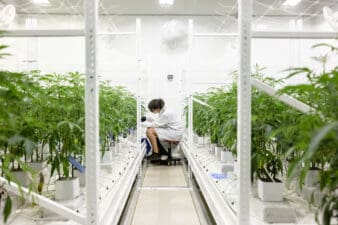Shares of Canada’s cannabis giant Canopy Growth (TSX:WEED)(NYSE:CGC) are trading at $20.47 at writing. Like most cannabis stocks, it’s taken a beating in the oast week. Canopy Growth stock fell 8.8% on March 7, 2020. It fell 15% in the last week and is down 63.5% in the last year.
Pot stocks have experienced an extended bear run due to structural issues including regulatory concerns, competition from the illegal market, mounting losses, high inventory levels and the slow rollout of retail stores in large Canadian markets.
But what drove cannabis stocks including Canopy Growth lower in the last week? The broader market has been impacted by a selloff on fears of lower consumer demand as the dreaded coronavirus outbreak continues to take a toll at the global level.
However, the cannabis sector was further impacted as Canopy Growth announced its plans to close two greenhouse facilities in British Columbia. This shutdown will also result in the elimination of 500 jobs.
The company stated that these actions are an effort to align supply with demand as well as to improve production efficiencies.
The greenhouse facilities in British Columbia account for close to 3 million square feet of licensed production space. These facilities were put into commission in February 2018 to help Canopy Growth scale up supply in Canada’s adult-use market.
Although recreational cannabis has been legalized for close to 18 months, the lower-than-expected demand has resulted in working capital and profitability challenges for most licensed producers.
Further, the federal regulations for outdoor cultivation were introduced after Canopy Growth pumped in millions to set up greenhouse production facilities.
Canopy’s press release states, “The company now operates an outdoor production site to allow for more cost-effective cultivation, which will play an important role in meeting demand on certain products that rely on cannabis extracts.
Following an organizational strategic review of production capacity and forecast demand, the company announced today that these facilities in Aldergrove and Delta, British Columbia are no longer essential to its cultivation footprint.”
Canopy Growth aims to reduce losses
Newly appointed CEO David Klein reaffirmed that one of the company’s key strategic objectives is to align business resources to meet consumer demand. It’s very clear the management wants to increase profit margins and cut mounting losses to be sustainable over the long term.
Canopy ended fiscal 2019 with an EBITDA of -$257 million. While analysts expect EBITDA losses to rise to $427 million in 2020, these losses are forecast to reduce to $215 million in 2021 and $35.6 million in 2022.
However, Canopy has the equity backing of Constellation Brands with a cash balance of $2.28 billion, giving it enough breathing space to increase profitability over time.
In the December quarter, Canopy reported a loss of $92 million, which was lower than the loss of $156 million in the September quarter.
The road ahead for pot investors will be bumpy and volatile. While the massive potential in the cannabis space will continue to boost investments, investors can expect a lot of marijuana companies to go bust.
Canopy Growth’s huge market presence, focus on profitability and a multi-billion-dollar investment from Constellation Brands will help the firm tide over short-term volatility.



